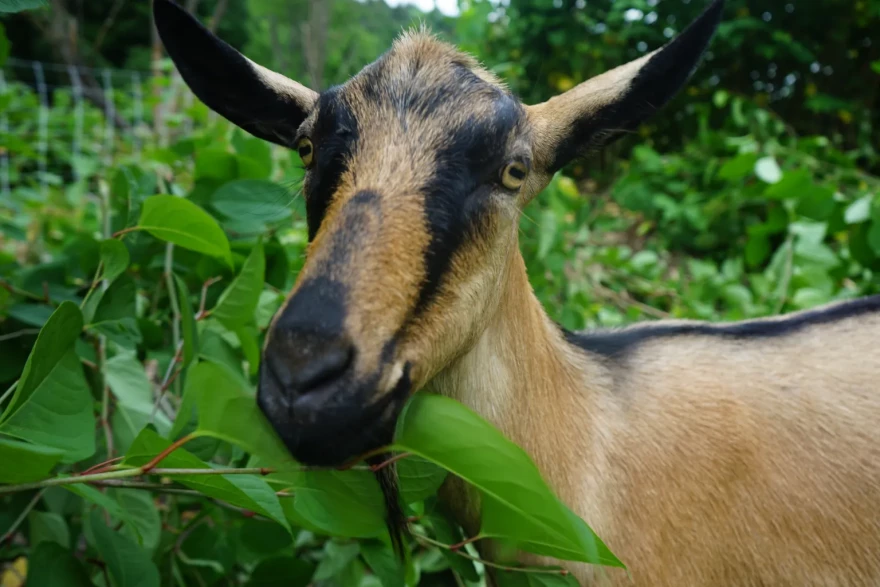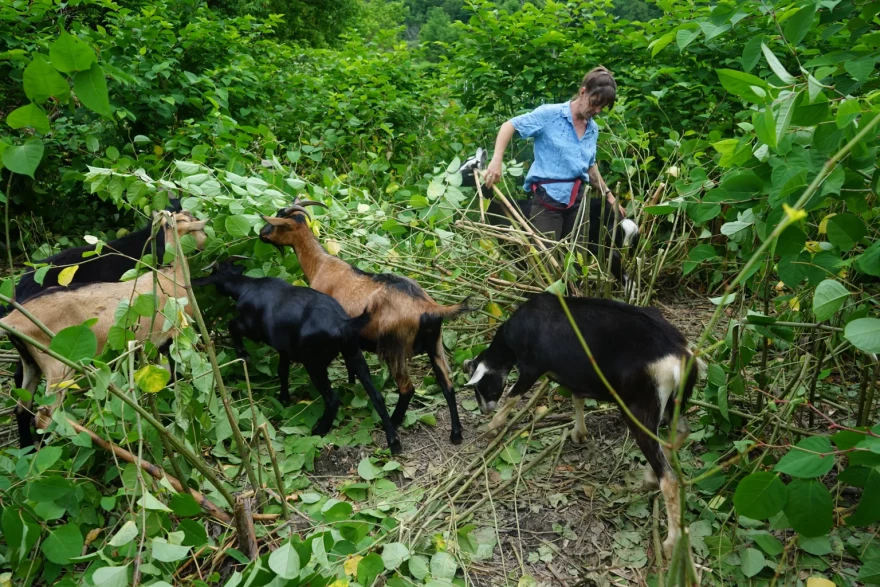MAD RIVER VALLEY — For the past seven years, volunteers have been pulling and clipping Japanese knotweed from riverbanks, open fields, roadsides and plenty of places in between.
They’re part of a joint effort between conservation commissions in three towns — Waitsfield, Warren and Fayston — to fight the invasive plant, which has taken hold along the Mad River Valley.
More recently, project leaders have enlisted a helping hoof: goats that can eat the knotweed up.
Goat grazing is a known method to control invasive plants without machinery. Goats feed on the plants, weakening or killing them entirely. In 2024, the Mad River Valley effort hired Mary Beth Herbert to do the job. This year, she’s funded by a grant from the Lake Champlain Basin Program.

According to Curt Lindberg, chair of the Waitsfield Conservation Commission, the project spans a cumulative 260 worksites across the region. Interns from the University of Vermont as well as local volunteers have been working, along with the goats, to control knotweed across the locations.
Herbert got her start with keeping goats in 2018 while working as a trail crew leader on the Appalachian Trail in the south of the state. She got interested in working with goats because of frequent machine failures on the job that set the crew behind.
She spent around five years camping on the trail with her goats, half the time as a volunteer, the other half paid.
In the same year she and her three goats — Ruth, Bader and Ginsberg, after the former U.S. Supreme Court justice — were hired by the city of Montpelier to remove poison ivy.
In the winter of 2023, Herbert gave away her then 23-strong herd and moved to Arizona to study with Navajo shepherds.

That spring, she was contacted by the Mad River knotweed operation to help rid the area of the invasive.
When efforts to remove knotweed first started out, locals found it challenging and had thought, “‘Why even bother,’” said Lindberg.
But in the past few years there has been a shift in perspective.
"With good persistent effort, you can make progress,” Lindberg said.
This year, Herbert has a herd of 18 goats, 14 of which she bought together and four she bought from Villa Villekulla Farm in Barnard.
The knotweed is extensive and dense, especially along the river.
On a recent day near the Mad River Exchange in Waitsfield, Herbert walked along a wooded trail toward the riverside clearing where her crew has been stationed this summer. Unlike the land around it, the field hasn’t been overwhelmed by knotweed; the patches are shorter and more spread out.

She’s been rotating the herd around the perimeter to prevent the invasive from growing any further.
“I already see a difference from last year to this year,” she said.
Around the field, knotweed grazed on four weeks ago had grown back to chest height while further away, ungrazed plants stood at least 6 feet high.
Unlike poison ivy, which can be grazed heavily one time, Knotweed needs more regular maintenance to suppress the spread.
“Knotweed needs to be grazed many, many times, over and over,” Herbert said.
Increased flooding in Vermont is worrisome to both her and Linberg for how it could fuel the spread of the invasive.

That’s because when floodwaters pass over riverbanks with a population of Japanese knotweed, they can carry rhizomes — the part of the plant that grows new roots and shoots — downstream, where the invasives can replant themselves into the soil and spread the network further.
The field where Herbert is working is public land that could turn entirely into knotweed if left unmanaged.
“The goal is to work where people used to go and can’t anymore because of the knotweed and reclaim” those spots, Herbert said.
The goats will be spending all summer eating knotweed around the field. They are moved every two or three days from one spot to another and cycle to previously grazed spots around every four weeks. On that recent afternoon, goats followed Herbert around as she kicked knotweed down to make it easier for them to reach.
“I’m happy because the goats absolutely love the knotweed,” Herbert said.

She sees animal husbandry as the most important part of her job. She trims the goats’ hooves, makes sure they get enough nutrition in their diet and sets up electric fences every time they are moved to keep them from wandering away or encountering coyotes.
Each year the knotweed is getting weaker in places the volunteers are working, Lindberg said. In some roadside spots, where the weed can’t spread as easily as by water, volunteers have eradicated the plant, he said.
Interns and volunteers are set to fight the knotweed into September. In October, volunteers will plant native plants.
“The goal is to restore healthy, native habitat,” Lindberg said.
The Community News Service is a program in which University of Vermont students work with professional editors to provide content for local news outlets at no cost.




